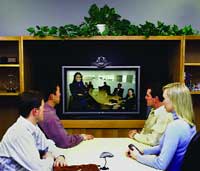It seems so long ago that an ambitious start-up named LifeSize Communications rocked the ho-hum videoconferencing industry by shipping the first high-definition, large-screen modular system for conference rooms, bringing a greater degree of realism than ever before. That was in December 2005. And in the ensuing year, much has happened.All the major vendors of videoconferencing hardware responded to LifeSize with HD systems of their own, and an immersive form of HD conferencing, the somewhat pretentiously named telepresence, took off like a rocket, with most of today's players jumping in just last fall. Strangely, while all this was happening, small PC cameras and cheap headsets finally started being taken seriously as business tools, thanks to affordable, secure, multipoint conferencing software.Vendors and analysts say that the two trends are combining to create the long-awaited popularization of enterprise class videoconferencing. 'We're at the calm before the storm,' said Barry Morris, vice president of federal operations at Polycom, the worldwide market share leader.Cisco Systems, Hewlett-Packard, Polycom and Teliris have now all shipped telepresence systems, and HP, which says it has sold at least 80 rooms outfitted with its Halo technology, formed a partnership with second-place Tandberg to bring thousands of Tandberg systems onto HP's private telepresence network, HVEN. According to HP marketing manager Ray Siuta, Halo will also run on a private agency network with sufficient bandwidth. 'The gee-whiz factor for our government customers is the level of video quality,' said Brent Byrnes, Cisco's regional manager for federal advanced technologies.Some observers say the telepresence bubble is helping drive demand for videoconferencing in general, since the systems' $300,000-$1 million price tags require 'C-level' buy-in from the same CIOs and CEOs who are likely both to use and approve the systems, which have executive-boardroom snob appeal. 'It's not a mass-deployment-type product,' said Ira Weinstein, senior analyst and partner at Wainhouse Research. 'It really is for the high flyers.'The prebuilt, remotely managed tele-presence rooms, which often ship in several large pallets and take a week to set up, employ the most bleeding-edge technology 'to take all the technology away from the user,' said Morris, noting that the Polycom RPX HD telepresence system, for example, has recessed microphones. The experience is so realistic for off-site participants, 'it's like they're walking into your conference room,' he said.While telepresence rooms are the ultimate in geek chic, Siuta sees the experience eventually becoming mainstream, perhaps even finding its way into tech-savvy homes as prices come down and more rooms get built. 'Make sure you have the rooms available to the entire employee population, because they will get used,' Siuta said.You need not dedicate a whole room as a telepresence center. A sufficiently sharp'and large'HD screen, compatible HD camera and clear audio are all that is required. Telepresence-quality HD is considered to be a screen at least 720 pixels high (720p in industry lingo) that shows broadcast-quality 30 frames per second (fps), though newer models can do 1,080p and 60 fps. 'You could actually have a telepresence solution for your desktop,' said John Atkins, Tandberg's senior federal solutions engineer.Charlie Crawford, vice president of operations at Criticom, a Washington-area integrator and hardware maker that sells high-security systems to federal agencies, agrees that high-end desktop HD is competitive with the pricey telepresence systems. 'Telepresence is a niche within the VTC [video teleconference] market,' Crawford said. 'A user can achieve a great percentage of that by just zooming into the people on the screen.'Traditionally a hardware-driven technology, videoconferencing has finally entered a phase in which primarily software-based solutions'either on-premise or hosted off site'can hold their own as secure, scalable, full-featured applications. Rapid advancements in the graphics power of Intel chip sets and their competitors gave every PC the necessary computing power, and the availability of broadband removed the last major performance hurdle.Dozens of small vendors crowd the market, and the major videoconferencing hardware vendors are jumping in, including Tandberg, which released its new Movi server software late last year. Joel Brunson, president of Tandberg's federal division, sees the software trend as part of an effort to reach Internet-raised 'Gen-Y' employees who value flexibility in work arrangements. 'All you need is Movi and one of those cheap little cameras,' Brunson said. 'It's a great data-sharing tool.''The history of conferencing is people started with the hardware solutions,' said Colin Smith, director of corporate communications at WebEx Communications, which provides on-demand, hosted conferencing. 'Those were a lot like stringing coffee cans, in my opinion. The only growing part of the marketplace right now is on-demand conferencing. People want this to be as easy as the telephone, and the only way you can do this is through a service provider.' Smith named Pennsylvania, and the federal departments of Corrections and Health and Human Services as major customers. He said the rise of hosted conferencing avoids the IT finger-pointing that has plagued the famously quirky videoconferencing systems.Yet most serious video meetings are still held in rooms because of the inherent nature of meetings, and sales of conference room systems continue to grow, said Robert Kipke, Criticom's vice president of sales. 'By and large, when people are using videoconferencing, they're talking in larger groups,' Kipke said.Many of the vendors employ the software-as-a-service model. Example: WiredRed Software, which claims the Federal Bureau of Investigation headquarters and Homeland Security Department among its customers. WiredRed's pitch is that it provides the desktop software and network infrastructure that can work with virtually any video and audio end point, removing worries about confusing standards, installation and maintenance. 'If we can't do it right now without getting on the phone with IT, it's never going to work in the long run,' said Steve Peltier, WiredRed's chief executive officer.In many ways, unified communications is the latest buzzword for the multimedia convergence that has been going on for years. It could soon bring major changes to the workplace by putting a rich toolkit of collaboration options on every employee's desktop. Peltier cites a scenario that will be possible with a new version of WiredRed's e/pop conferencing software planned for the third quarter.Co-workers could use instant messaging to arrange a phone conference over their voice over IP phones, then quickly escalate to video if the conversation calls for it. First-responder organizations already use e/pop's alert-messaging feature to quickly broadcast information that requires urgent attention.The Utah Department of Natural Resources has been using the hosted version of e/pop at 10 of its 12 widely dispersed offices since August of last year to avoid travel costs, according to public affairs spokesman Jason Curry. The state maintains a single, Polycom-based conferencing site that isn't convenient for department staff. 'We did a fairly informal analysis of how much travel we would have done to get to headquarters in Salt Lake City,' Curry said. 'We figured we could recoup our costs very quickly.'The two traditionally separate worlds of document-centric conferencing, typically called Web conferencing, and video-centric conferencing are finally merging, more or less seamlessly. 'In 98 percent of every videoconference I've even been in, at some point someone is holding up a sheet of paper,' Smith said. 'Ninety percent of WebEx meetings have maybe two to three minutes of video'the rest is focused on the work,' said Smith, though he noted an uptick in video use in the past two years. HP concedes documents' primacy, too, by outfitting the higher end of its Halo rooms with an HD camera dedicated to zooming in on paper. 'Videoconferencing is becoming a feature behind other apps, and it should be,' Weinstein said. 'The minute video becomes the focus of your meeting, it's no longer a meeting.'Though still in the throes of the HD and unified communications trends, videoconferencing has an eye to its next frontier: third- and fourth-generation (3G and 4G) digital cellular networks that bring video meetings to phones and personal digital assistants.It's already happening in Europe and Asia, where 3G is well-established, but the United States has been notoriously behind. When 3G does hit, purportedly in several major cities this year, major hardware vendors including Tandberg should release 3G gateways like the ones they now sell only overseas.
Smile, you're on: Polycom's VSX7000 pushes the state of the art in videoconferencing systems, offering higher resolution and better sound.
Screen Time: Tandberg's 1700 MXP serves the executive office.
See here: Polycom recently released its HDX videoconferencing systems.
Vendor |
Representative Product(s) |
Notes |
Adobe Systems Inc.
San Jose, Calif.
(408) 536-6000
www.adobe.com |
Adobe Acrobat Connect
(formerly Macromedia Breeze) |
Software; unique meeting-room Web addresses, monthly hosted service, Whiteboarding, chat, Acrobat/Acrobat Reader 8 documents, screen sharing |
Aethra Inc.
Miami
(888) 423-8472
www.aethra.com
|
AVC HD
Vega X5
|
Simultaneous HD audio and video, up to nine IP and ISDN sites, industry-standard, rackmount codec with built-in multpoint control unit, separate camera (included)
Set-top device for medium-to-large rooms; up to 8 IP and ISDN sites, continuous presence, dual data/video streams, voice tracking for camera
|
Cisco Systems Inc.
San Jose, Calif.
(800) 553-6387
www.cisco.com |
Cisco Telepresence |
True HD 1080p, 720p, 12-person "virtual table" (six per room), 65-inch plasma screen, 30 fps, ultrawideband audio |
Hewlett-Packard Co.
Palo Alto, Calif.
(650) 857-1501
www.hp.com
|
HP Halo Collaboration Studio |
HD telepresence system; high-bandwidth managed network, remote diagnostics, calibration, maintenance, separate collaboration screen, magnified document camera |
LifeSize Communications Inc.
Austin, Texas
(877) 543-3749
www.lifesize.com
|
LifeSize Room |
HD 720p for medium/large groups; four audio and video sites, super-wideband speakerphone, dual data/video streams, Outlook scheduling, dual-camera support
|
Polycom Inc.
Pleasanton, Calif.
(800) 765-9266
www.polycom.com |
Mobile Responder
Polycom HDX 9000 Series
|
FAA-approved ruggedized case with handle, wheels, 17-inch screen, integrated speaker and microphone, AES encryption, opt. KG encryption, second camera
HD 720p, 30 fps at 1Mbps and above, separate camera, codec, speakerphone, optional four- or eight-way multipoint bridge, Siren 22 stereo
|
Radvision Ltd.
Fair Lawn, N.J.
(201) 689-6300
www.radvision.com |
Click to Meet Platform
(formerly CUseeMe) |
Software; client/server multipoint voice, video and data, telephone/videoconferencing
integration, Works with IBM Lotus Sametime, Microsoft Outlook, Office Communicator |
Sony Electronics Inc.
Park Ridge, N.J.
(800) 686-7669
www.sony.com |
PCS-HG90 |
HD 720p, 60fps codec; opt. camera, four sites via internal multipoint control unit, analog or digital PC, SD, and HD input, MPEG-4 stereo
|
Tandberg
New York
(800) 538-2884
www.tandberg.com |
Tandberg Centric 1700 MXP
Tandberg Content Server (TCS)
|
All-in-one HD 720p executive system; 20-inch widescreen LCD, four video, three audio, sites,automatic downspeeding
Video production, recording and optimization, on-demand playback, 1U rackmountable,
five concurrent videoconferences, unicast and multicast streaming, four content inputs
|
Teliris Ltd.
New York
(212) 490-1065
www.teliris.com |
Teliris VirtuaLive HD |
Prebuilt room, modular, personal-executive and collaboration versions; HD 720p, no perceived latency, eye-level synchronziation, managed Teliris InfinNET network
|
WebEx
Communications Inc.
Santa Clara, Calif.
(408) 435-7000
www.webex.com
|
WebEx |
Web conferencing software (document sharing and audio/video conferencing); low-latency private network; pay-per-use, monthly and branded hosted versions, four-camera multipoint
|
WiredRed Software
San Diego
(858) 715-0970
www.wiredred.com |
e/pop Web Conferencing |
Software; hosted and on-premise desktop
multipoint VoIP/video/Web conferencing and
collaboration; standard firewall traversal, record/playback, secure instant messaging, remote control
|
* All products are hardware except where noted
HD = High Definition / MCU = Multipoint Conferencing Unit David Essex is a freelance technology writer based in Antrim, N.H.






